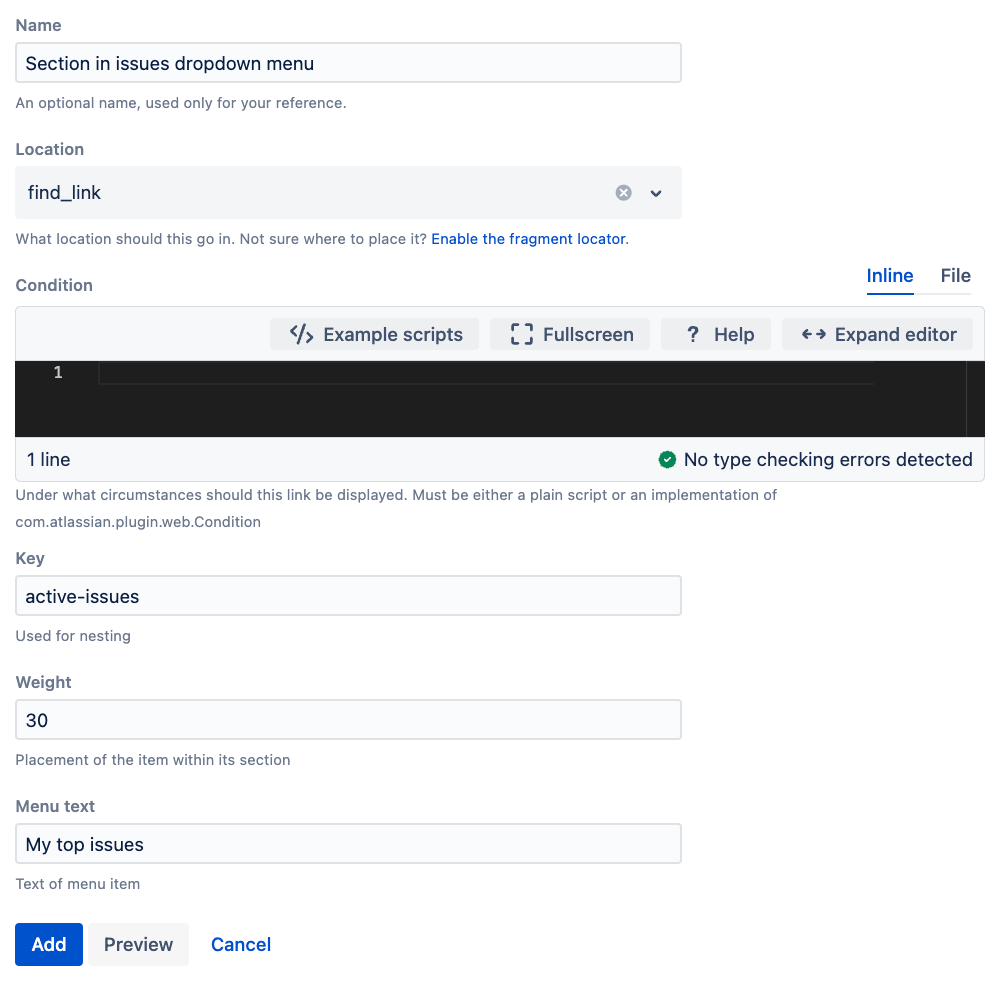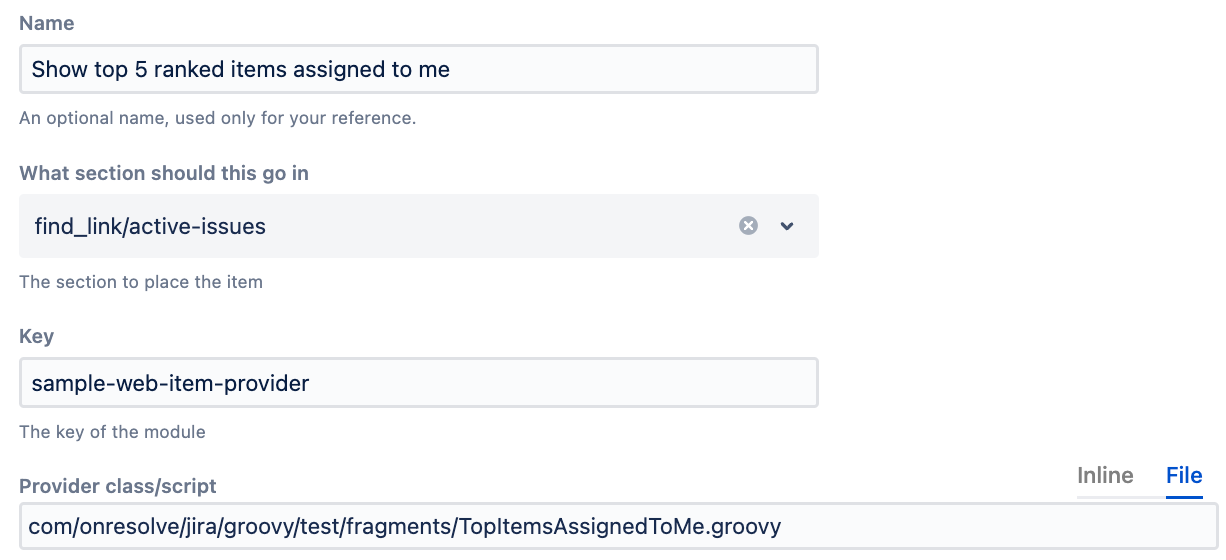Web Item Provider Built-In Script
Jira 10 Update
We are waiting on a Jira version to provide new API's that we rely on for our Web Item Providers. Any new or existing Web Item Provider configurations will not work until the new APIs are available (Estimated to be available in Jira 10.0.2). For more information on this, please check SRPLAT-2596 - Getting issue details... STATUS .
You have seen that we can add web items to new or existing web sections, and use conditions to determine whether they should be displayed for the current user, or issue, page etc.
However, if you want to dynamically generate web items according to the current circumstances, you need a web item provider. Official documentation is lacking, vote for PLUGFRAG-17.
Examples of a web item provider might be:
Show the top 5 issues for the current user in active sprints in the Issues top-level menu
Show a web item in the More Actions menu for each of the current issue’s subtasks
Usage
First of all, let’s look at a simple example. For the web item provider, you must either provider a class that implements com.atlassian.plugin.web.api.provider.WebItemProvider or, more simply, a script that returns a collection of com.atlassian.plugin.web.api.WebItem.
Using the com.atlassian.plugin.web.model.WebFragmentBuilder import is the easiest way to create a WebItem collection.
Set up the fragment like in the following screen capture:
The provider class/script can either be under a script root or inline. Here is a simple example:
import com.atlassian.plugin.web.model.WebFragmentBuilder
["Foo", "Bar", "Quz"].collect {
new WebFragmentBuilder(50). // <1>
id("sample-web-item-${it.toLowerCase()}"). // <2>
label("$it Sample Web Item").
title("$it Sample Web Item Title").
styleClass("").
addParam("data-my-key", "data-value"). // <3>
addParam("iconUrl", "/jira/images/icons/priorities/highest.svg"). // not all places will show icons
webItem(""). // <4>
url("/").
build()
}Line 4: The 50 refers to the weight of the item
Line 5: Give each web item a unique ID
Line 9: Additional data element items
Line 11: This parameter refers to the section, but it’s defined by the section for the context provider itself. i.e. it uses the section you choose in the 'Custom web item provider' form, so you can leave this blank as an empty string.
There are a couple of shortcuts in this script that can be confusing. No return statements are used (as the result of the last statement is returned in groovy). So the collect returns the web items.
Example: My Top Issues
I often find I am distracted by email, instant messaging etc, and that Jira doesn’t always get me back on track. This example is supposed to provide a quick cue by displaying the most important issues I should be working on, where most important is defined as the top five issues assigned to the current user in active sprints, ordered by rank. The finished result looks like:
There are two parts to this - one is a web item provider which will run the query, fetching at most 5 results, and return them as web items. The other is a new section in the Issues menu to add them to. The web section is configured like so:
The web item provider:
The code to generate the web items:
groovyimport com.atlassian.jira.bc.issue.search.SearchService import com.atlassian.jira.component.ComponentAccessor import com.atlassian.jira.jql.parser.JqlQueryParser import com.atlassian.jira.security.JiraAuthenticationContext import com.atlassian.jira.util.velocity.VelocityRequestContextFactory import com.atlassian.jira.web.bean.PagerFilter import com.atlassian.plugin.web.model.WebFragmentBuilder def jqlQueryParser = ComponentAccessor.getComponent(JqlQueryParser) def query = jqlQueryParser.parseQuery("assignee = currentUser() and resolution is EMPTY and sprint in openSprints() order by rank") def searchService = ComponentAccessor.getComponent(SearchService) def jiraAuthenticationContext = ComponentAccessor.getComponent(JiraAuthenticationContext) def searchResults = searchService.search(jiraAuthenticationContext.getLoggedInUser(), query, new PagerFilter(0, 5)) // <1> def velocityRequestContextFactory = ComponentAccessor.getComponent(VelocityRequestContextFactory) def requestContext = velocityRequestContextFactory.getJiraVelocityRequestContext() def baseUrl = requestContext.getBaseUrl() searchResults.results.collect { issue -> def issueLabel = "${issue.key} ${issue.summary}" String iconUrl = issue.issueType.iconUrl if (!iconUrl.startsWith("http://") && !iconUrl.startsWith("https://")) { iconUrl = baseUrl + iconUrl } new WebFragmentBuilder(50). id("sample-web-item-${issue.key.toLowerCase()}"). label(issueLabel). title(issueLabel). styleClass(""). addParam("class", "issue-link"). addParam("data-issue-key", issue.getKey()). addParam("iconUrl", iconUrl). webItem(""). url(baseUrl + "/browse/" + issue.getKey()). build() }
Line 14: Get at most 5 issues





